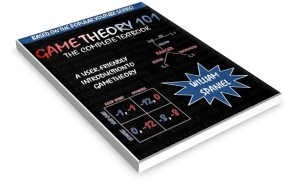In previous lectures, we have seen how to find pure strategy Nash equilibria. Sometimes the methods will not find any. However, Nash’s Theorem says that all finite games have at least one Nash equilibrium. What are we missing?
The answer is mixed strategy Nash equilibrium. When a player selects a mix strategy, he or she randomizes among two or more pure strategies. This lesson uses matching pennies to introduce the concept of mixed strategy Nash equilibrium.
Takeaway Points
- If the game is finite and there are no pure strategy Nash equilibrium, then there must be a mixed strategy Nash equilibrium.
- In a mixed strategy Nash equilibrium, at least one of the players plays multiple strategies with positive probability.
- This mixed strategy leaves the opponent indifferent to playing his pure strategies. (When there are more than two strategies, this gets a little more complicated—it may be the mixed strategy leaves the other player indifferent between playing two of his strategies and strictly worse off playing a third.)
- The mixed strategy that makes the opponent indifferent is not always obvious. We need to develop an algorithm to do that, which is the subject of the next lecture.

